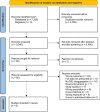Racial and ethnic differences in the risk of recurrent preterm or small for gestational age births in the United States: a systematic review and stratified analysis
- PMID: 38825670
- PMCID: PMC11145770
- DOI: 10.1186/s40748-024-00181-9
Racial and ethnic differences in the risk of recurrent preterm or small for gestational age births in the United States: a systematic review and stratified analysis
Abstract
Background: The risk of recurrent adverse birth outcomes has been reported worldwide, but there are limited estimates of these risks by social subgroups such as race and ethnicity in the United States. We assessed racial and ethnic disparities in the risk of recurrent adverse birth outcomes, including preterm birth, low birthweight, fetal growth restriction, small for gestational age, stillbirth, and neonatal mortality in the U.S.
Methods: We searched MEDLINE, CINAHL Complete, Web of Science, and Scopus from the date of inception to April 5, 2022. We identified 3,540 articles for a title and abstract review, of which 80 were selected for full-text review. Studies were included if they focused on the recurrence of any of the six outcomes listed in the objectives. Study quality was assessed using the NIH Study Quality Assessment Tool. Heterogeneity across studies was too large for meta-analysis, but race and ethnicity-stratified estimates and tests for homogeneity results were reported.
Results: Six studies on recurrent preterm birth and small for gestational age were included. Pooled comparisons showed a higher risk of recurrent preterm birth and small for gestational age for all women. Stratified race comparisons showed a higher but heterogeneous risk of recurrence of preterm birth across Black and White women. Relative risks of recurrent preterm birth ranged from 2.02 [1.94, 2.11] to 2.86 [2.40, 3.39] for Black women and from 3.23 [3.07, 3.39] to 3.92 [3.35, 4.59] for White women. The evidence was weak for race and ethnicity stratification for Hispanic and Asian women for both outcomes.
Conclusions: Disparities exist in the recurrence of preterm birth, and race/ethnicity-concordant comparisons suggest race is an effect modifier for recurrent preterm birth for Black and White women. Due to the small number of studies, no conclusions could be made for small for gestational age or Hispanic and Asian groups. The results pose new research areas to better understand race-based differences in recurrent adverse birth outcomes.
Keywords: Low birthweight; Neonatal mortality; Preterm birth; Racial disparities; Recurrence; Small for gestational age; Stillbirth.
© 2024. The Author(s).
Conflict of interest statement
The authors declare no competing interests.
Figures


Similar articles
-
Effects of race and ethnicity on perinatal outcomes in high-income and upper-middle-income countries: an individual participant data meta-analysis of 2 198 655 pregnancies.Lancet. 2022 Dec 10;400(10368):2049-2062. doi: 10.1016/S0140-6736(22)01191-6. Lancet. 2022. PMID: 36502843
-
US birth weight/gestational age-specific neonatal mortality: 1995-1997 rates for whites, hispanics, and blacks.Pediatrics. 2003 Jan;111(1):e61-6. doi: 10.1542/peds.111.1.e61. Pediatrics. 2003. PMID: 12509596 Free PMC article.
-
The association between maternal stature and adverse birth outcomes and the modifying effect of race and ethnicity: a population-based retrospective cohort study.AJOG Glob Rep. 2023 Feb 18;3(2):100184. doi: 10.1016/j.xagr.2023.100184. eCollection 2023 May. AJOG Glob Rep. 2023. PMID: 36941862 Free PMC article.
-
Risk of stillbirth, preterm delivery, and fetal growth restriction following exposure in a previous birth: systematic review and meta-analysis.BJOG. 2018 Jan;125(2):183-192. doi: 10.1111/1471-0528.14906. Epub 2017 Oct 3. BJOG. 2018. PMID: 28856792
-
Does race or ethnicity play a role in the origin, pathophysiology, and outcomes of preeclampsia? An expert review of the literature.Am J Obstet Gynecol. 2022 Feb;226(2S):S876-S885. doi: 10.1016/j.ajog.2020.07.038. Epub 2020 Jul 24. Am J Obstet Gynecol. 2022. PMID: 32717255 Review.
References
-
- Malacova E, Regan A, Nassar N, Raynes-Greenow C, Leonard H, Srinivasjois R, et al. Risk of stillbirth, preterm delivery, and fetal growth restriction following exposure in a previous birth: systematic review and meta-analysis. BJOG Int J Obstet Gynaecol. 2018;125(2):183–92. doi: 10.1111/1471-0528.14906. - DOI - PubMed
-
- Zacharias N. Perinatal mortality. Martin R, Wilkie L, editors. UpToDate [Internet]. 2020; Available from: https://www-uptodate-com.dartmouth.idm.oclc.org/contents/perinatal-morta...
Publication types
LinkOut - more resources
Full Text Sources
Miscellaneous

